6.1. Creating Charts You can talk numbers until you're blue in the face, but when you really want to get your audience's attentionand get your point across in the shortest time possibleyou need a chart. Sometimes referred to as a graph , a chart is nothing more than a visual representation of a bunch of numbers. The ubiquitous pie chart (Figure 6-1) breaks up a circular area into easy-to-understand, color -coded wedges, each of which represents a numerical quantity. PowerPoint 2007 lets you add punch to your presentations with the same bar charts, line charts, scatter graphs, and so on that PowerPoint 2003 offered . Only now they're better looking, since Microsoft Excel has replaced PowerPoint 2003's Microsoft Graph program. 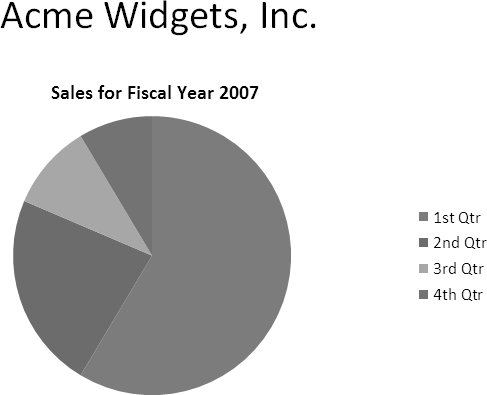 | Figure 6-1. Charting is an art unto itself, as all liars and statisticians are well aware. PowerPoint doesn't care whether the numbers you chart are accurate or whether your chart makes your conclusions dangerously misleadingit leaves those judgments up to you. | |
Note: You don't need to have Excel installed on your computer to create charts. If PowerPoint 2007 finds Excel on your PC, it uses Excel. Otherwise, it falls back on the built-in graphics program, Microsoft Graph. See the box on page 178 for the full scoop.
Creating a chart in PowerPoint is a straightforward process. You tell the program which type of chart you want to create (pie chart, bar chart, and so on), you type a few rows of data into an Excel (or Graph) spreadsheet, and then you apply a predesigned Chart Style and Chart Layout. Bingoinstant chart. And if you've never seen a chart built with an Office 2007 program, you'll be amazed how good it looks. For most folks, that's all there is to charting in PowerPoint. But you can take it a bit further. You can tweak and adjust the individual elements of your chartthe grid lines, the data labels, the legend, the title text, and on and onto create the unique, supremely effective chart you envision.
Tip: If you prefer, make the chart in another program and paste in onto a PowerPoint slide. Page 191 shows you how.
6.1.1. Choosing a Chart Type PowerPoint's charts look great, but they're not all suited to every type of information. Do you know which one to choose? The chart type you pick affects how PowerPoint interprets your information, which affects your audience's conclusions. So choose a chart type based on what you're trying to communicate, not on what PowerPoint lets you do. Charting is both art and science, and it's far too complex to tackle in a book about PowerPoint. Consider the following descriptions in deciding which type of chart to create: -
Bar chart. One of the most popular types of charts, the bar chart depicts numberslike dollars, products sold, or the number of times something happenedusing big, thick, hard-to- miss rectangles. Bar charts show numbers in the context of time. They can show how many field goals each high school's football team scored over the last five seasons. Bar charts can be stacked , which means PowerPoint stacks all of the data from all of the categories into one bar per event; or they can be clustered , which means that each data category gets its own bar for each event. -
Column chart. A column chart's the same as a bar chart, but lying on its side (with x- and y-axis labels flipped to match). Fancy types of column charts include cylinder, cone , and pyramid . -
Line chart. Line charts show noncumulative data horizontally, over time, so you can track performance. Consider a line chart if, for example, you're trying to show the progression of your company's quarter-by-quarter performance over the past fiscal year, compared with your two closest competitors ' performances over that same period of time. Similar to bar charts, line charts track numbers in relation to time. But unlike bar charts, which clump the data for specific events (like field-goal totals for those five football seasons), line charts show a continuous intersection of activity. Thus, if it's events you're interested in comparing, then use a bar chart; when it's a continuous progression of up-and-down movement, use a line chart. -
Pie chart. Because pie charts show percentage values as slices of a circle, this type of chart makes sense only if you have a single column of numbers that add up to 100. For example, you can use a pie chart if you're trying to show how much of every dollar raised for your charity goes to overhead, to individual programs, and so on. -
Scatter chart. Use a scatter chart when you're working with data that neither occurs at regular intervals nor belongs to a series. Sometimes referred to as XY charts or scatter graphs , scatter charts show information as points distributed around an x-y axisthink darts thrown at a dartboard. The dots give a quick visual showing the relationship between the data represented by the x and y axes. You might use a scatter chart to plot the relationship between the prices of ovens and how long the ovens last. Scatter charts are popular with scientists. -
Area, bubble, doughnut, stock, surface, and radar charts. Theoretically, you can graph any data you want any way you want, and in this spirit PowerPoint offers the doughnut, stock, radar, and other specialty graphs. Remember, though, the more complicated a graph is, the harder it is for your audience to understand iteven if you're there in person to explain it. And complexity totally defeats the purpose of a graph. Most of the time you should stick with the bar, column, line, and pie charts. If your message and your data really do require something more sophisticated, like a radar graph, press F1 in either Excel or PowerPoint to get chart-specific pointers. A radar graph is useful for comparing the aggregate values of a bunch of data series. Say you want to compare the vitamin levels of three different brands of orange juice. Creating a radar chart lets your audience see at a glance which brand of juice contains the most Vitamin C, Vitamin D, Vitamin A and which is the most nutritious overall.
Note: Figures 6-2 and 6-3 show you the different configuration your numbers and headings need to work with the different kinds of charts PowerPoint lets you create.
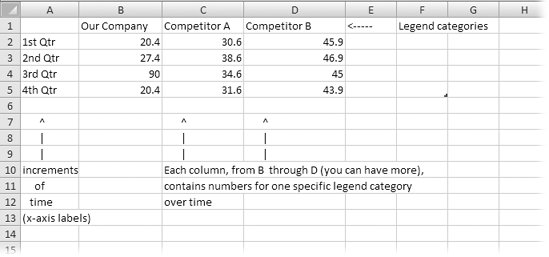 | Figure 6-2. The mocked-up data PowerPoint starts you off with would be a lot more useful if the program gave you a clue of how to interpret each cell . Here's how your data needs to appear for the Bar, Column, and Line charts (the ones that, along with Pie charts, you're most likely to use). | |
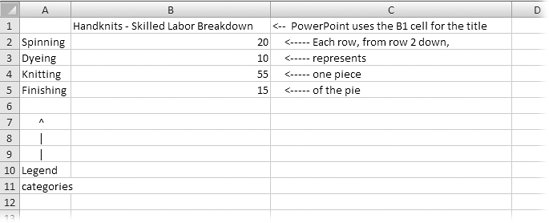 | Figure 6-3. Because pie charts can deal with only one category of numbers (in chart-speak, one data series), you need to arrange your figures as shown here for PowerPoint to graph your pie chart correctly. Also double check your data range, since PowerPoint doesn't always extrapolate correctly. | |
Note: PowerPoint lets you convert a chart to a different type with the click of a button (Chart Tools Design  Type Type  Change Chart Type), but be aware that the switch may affect your data. Switching from a line chart to a pie chart can produce a slick-looking result, but it tells PowerPoint to ignore all but one category of datawhich can obviously have disastrous consequences if what you really intended to convey was the relationship between two categories. Change Chart Type), but be aware that the switch may affect your data. Switching from a line chart to a pie chart can produce a slick-looking result, but it tells PowerPoint to ignore all but one category of datawhich can obviously have disastrous consequences if what you really intended to convey was the relationship between two categories.
6.1.2. Creating a Chart To create a chart, first tell PowerPoint what type of chart you want, and then feed it some data. The steps that follow explain how.
Note: Creating a chart is pretty simple, as you'll see in the following steps. But if you're new to Excel or spreadsheets in general, it's useful to walk through the process visually. A screencast at www.missingmanuals.com shows you how to create a chart in PowerPoint, complete with accompanying narration that explains each step.
-
Click Insert. The Insert tab you see in Figure 6-4 appears.  | Figure 6-4. If you've applied a Title and Content or Comparison layout to the slide you're adding your chart to, you'll see two versions of the Chart icon: one on the Insert ribbon (as shown here) and one in the center of your slide. Clicking the Chart icon in either location displays the Create Chart dialog box shown in Figure 6-5. | | -
Click Chart. The Insert Chart dialog box (Figure 6-5) appears.  | Figure 6-5. The Insert Chart dialog box offers dozens of different types of charts. PowerPoint doesn't support live previews for charts the way it does for just about everything else, but it does display short descriptions as you mouse over each chart icon. (You can always switch to a different type after you add a chart, as described on page 185.) | | -
Choose the kind of chart you want to add to your slide, and then click OK. To find one you like, zip to the left side of the Insert Chart dialog box (Figure 6-5) and click a category (such as Bar, Area, or Doughnut), which whisks you straight to the section you're interested in. Or, if you prefer, you can use the scroll bar to browse leisurely through all the chart options.
Note: You can also double-click a chart type to add it to your slide.
Once you click OK, PowerPoint shrinks to half size and scoots over to make room for Excel, which appears on the right side of your screen complete with placeholder data displayed in an Excel spreadsheet titled "Chart in Microsoft Office PowerPoint." In PowerPoint, the Chart Tools Design, Chart Tools Layout, and Chart Tools Format tabs appear (Figure 6-6). 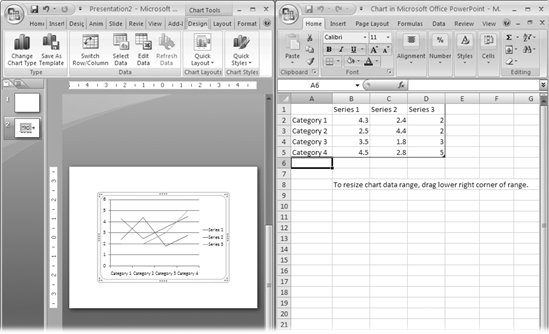 | Figure 6-6. Excel starts you off with a column or two of mocked-up dataone piece of information per spreadsheet cellso that you can get a feel for what your chart will look like. To expand the tiny chart preview PowerPoint displays on your slide, in PowerPoint either click Zoom a few times or drag the Zoom slider. | | -
Replace the mocked-up data you see in Excel with the real data you want to chart. To do so, you can: -
Click in each cell and type your own numbers and headings. -
If you've already got a spreadsheet containing the numbers you want to chart, you can copy the cells from that spreadsheet and paste them into the spreadsheet PowerPoint gives you. (For quick tips on pasting from Excel, see the box on page 182.) As you add, change, and delete data in the Excel spreadsheet, Excel's data range outline automatically changes to encompass your new data columns and headings, and your PowerPoint chart updates automatically to reflect your changes. FREQUENTLY ASKED QUESTION
Creating Charts Without Excel | | PowerPoint uses Excel to do all its charting now. But I don't have Excel, just PowerPoint. Does that mean I can't do charts? Microsoft Office comes with both programs, so lots of people who use Office have both PowerPoint and Excel installed on their computers. But not everyone who installs Office chooses to install both programsand some folks choose to buy just PowerPoint, not the entire Office suite. If you do have both PowerPoint and Excel installed on your computer, creating a chart in PowerPoint automatically kicks Excel into gear, as shown in this chapter. But if you don't have Excel installed, you can still create charts. Here's why: when PowerPoint can't find Excel, it automatically launches Microsoft Graph, the same charting and drawing program that came with PowerPoint 2003. Microsoft Graph doesn't offer the same bells and whistles that Excel doeswhich is why Microsoft replaced it with Excel in PowerPoint 2007but you can use it to do the same basic things. For example, you can click in Microsoft Graph data cells to type in your own numbers and column headings, just the way you can in Excel. This book focuses on creating charts in PowerPoint (and not Excel), so all of the instructions work the same for you as they do for someone who has Excel installedeven if what you see on your screen looks slightly different from the figures in this book. But if you run into a snag, then click the Microsoft Graph spreadsheet and choose Help  Microsoft Graph Help. Microsoft Graph Help. | -
Click anywhere on your PowerPoint slide. PowerPoint whisks you back to slide-editing mode and updates your chart with the data you just gave it.
Tip: If your spreadsheet accidentally disappears (perhaps you clicked the X in the upper-right corner by mistake), you can get it back again by selecting your chart and then choosing Chart Tools Design  Data Data  Edit Data. Edit Data.
6.1.3. Customizing Charts with Prebuilt Layouts and Styles In earlier versions of PowerPoint, you could set every minute detail of your chart. You could tell PowerPoint precisely where you wanted it to display your chart's title. You could add a legend across the bottom of the chart and display gridlines across the body, and so on. GEM IN THE ROUGH
Trying Data on for Size | | PowerPoint lets you pinpoint the perfect chart by "trying out" different sets of data. This is useful if you want to experiment to find out which of several sets of data translates to the most dramatic chart. Here's how it works: -
Create a chart as described on page 175. -
Choose Chart Tools Design  Data Data  Select Data to display your spreadsheet (if it isnt visible already) and to display the Select Data Source dialog box. Select Data to display your spreadsheet (if it isnt visible already) and to display the Select Data Source dialog box. -
In your spreadsheet, create another complete set of data; then click the new data range and drag to outline your newly created columns and rows. Notice that PowerPoint automatically adjusts the Select Data Source dialog box to reflect your changes. -
In the Select Data Source dialog box, click OK to tell PowerPoint to update your chart using your new data. -
Repeat steps 3 and 4 for as many sets of data as you have. After you've decided to stick with one, don't bother deleting the others from your spreadsheet. Leave them there in case you change your mind. |
You can still make these tweaks in PowerPoint 2007 but instead of making you hunt-and-click your way to a decent-looking chart, PowerPoint 2007 gives you the option of choosing both a canned Chart Layout and a canned Chart Style scheme. Here's how it works: You pick one of PowerPoint's professionally designed Chart Layout schemes, some of which show the legend on the side of the chart, some at the bottom, and so on. Then you pick one Chart Style scheme, which sets the colors, data point markers, and a background for your chart. At that point, you're 90 percent of the way to a great-looking chart. (You'll see how to tweak the last couple of items to get to 100 percent starting on page 181.) 6.1.3.1. Applying prebuilt Chart Layouts Since you're going to be working on your chart's appearance, give yourself a nice big view. If PowerPoint isn't maximized on your computer screen, click the Maximize button in the upper-right corner of the window to maximize it. Then follow these steps: -
On your slide, click your chart to select it. PowerPoint displays the Chart Tools contextual tab. -
Go to Chart Tools Design tab. You see tools for formatting your chart's looks (Figure 6-7).  | Figure 6-7. Confusingly, when you select a chart, two Design tabs appear: the regular Design tab, and the Chart Tools Design contextual tab. PowerPoint highlights the contextual tab to make it stand out a bit. The Chart Tools Design tab is specifically for working with your chart. | | -
Click the Chart Layout gallery to expand it (Figure 6-8). Then click to choose the layout you want to apply to your chart. PowerPoint redisplays your chart based on the layout you chose.  | Figure 6-8. The Chart Layout gallery varies depending on the type of chart you choose. Layouts define where chart elements such as titles, legends, and data and axis labels appear. This gallery shows the layouts that PowerPoint can apply to Line charts. | | 6.1.3.2. Applying prebuilt Chart Styles The Chart Style schemes that come with PowerPoint give you a quick way to choose the color of your chart's data elements, as well as your chart's background. Because all of the colors in the Chart Style schemes are professionally designed to coordinate with each other, your chart looks good no matter which one you chooseand no matter how many data elements you're charting. To apply a Chart Style: -
On your slide, click your chart to select it. Then go to Chart Tools Design tab. Tools for formatting your chart's appearance show up on the ribbon. -
Click to expand the Chart Styles gallery (Figure 6-9). From the Chart Styles gallery, click to choose the style you want to apply to your chart. PowerPoint redisplays your chart based on the style you chose. 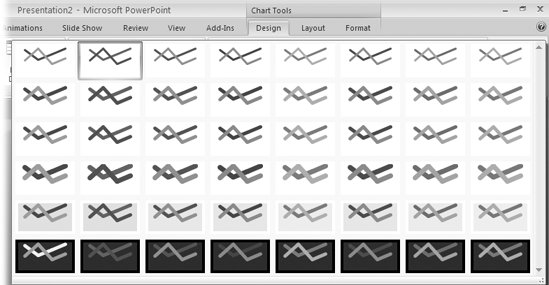 | Figure 6-9. The Chart Styles gallery gives you a super-easy way to apply an attractive color scheme (including background colors and gradients) to your charthere, a line chart. You can tweak the colors if you like, of course (see pages 90 and 308). | | 6.1.4. Editing and Tweaking Charts Even if you depend on PowerPoint's Chart Layout and Chart Style schemesand you really, really shouldyou'll still want to tweak your chart a bit before it's ready for the big time. Whether you want to customize your chart's title, legend, data labels, or whatever, PowerPoint gives you two basic methods : -
Right-click your chart. Then, choose a customization option from the menu that appears. -
Click your chart and go to the ribbon. You'll find customization tools on the Chart Tools Design, Chart Tools Layout, and Chart Tools Format tabs. This section walks you through the options on the Chart Tools tabs. When you right-click your chart, PowerPoint displays options you're likely to need depending on which chart element your cursor is over when you right-click.
Tip: In addition to the popular chart-editing options described in this section, PowerPoint lets you do things like add and format data series, format your chart's plot area, and much more. For example, you can tell PowerPoint to explode a pie chartand how much to explode it. Or you can tell PowerPoint to paste a data label on each column in a column chart. To see the customization options available for your particular chart type, right-click your chart.
6.1.4.1. Editing data ranges If your chart doesn't look quite right, it may be because PowerPoint is charting the wrong data range. As explained on page 178, not only do you have to give PowerPoint the right data; you also have to tell it which range of data cells you want it to chart. Fortunately, you can view your chart's underlying chart range and edit it as often as you need to. See the following list to learn how. POWER USERS' CLINIC
Excel: The Least You Need to Know | | If you really want to get down and dirty with Excel, you need a good reference on the subject. (One to try is Excel 2007: The Missing Manual , by Matthew MacDonald.) But when all you want to do is to put together a decent-looking chart in PowerPoint and then get on with your life, you'll do all right if you know how to: Copy and paste cell data from an existing spreadsheet. You've already got a spreadsheet containing the data you want to chart, and you don't want to retype it into the spreadsheet PowerPoint provides. Copy and paste the data. Here's how: -
In the Excel spreadsheet PowerPoint opened (the one titled "Chart in Microsoft Office PowerPoint"), choose Office button  Open and open a new spreadsheet (the spreadsheet containing the data you want to chart). Open and open a new spreadsheet (the spreadsheet containing the data you want to chart). -
Copy (or press Ctrl+C) to copy it. -
Paste or press Ctrl+V to paste the data. Delete the contents of cells. PowerPoint always knows exactly which cells you want to chart because you tell it (as in the previous set of steps). But if you've copied and pasted a few times, you may get confused even if PowerPoint doesn't. To clear out the contents of cells you don't want to chart (and don't want to see), drag to select the cells; then right-click the selection and choose Clear Contents from the shortcut menu Widen columns. If you type text into two side-by-side cells, you may not be able to read all the text in the first cell. One way to get around this problem is to widen the first cell's column. To do so, click the edge of the column header and drag to widen the entire column. Insert and delete rows and columns. You're halfway finished typing the numbers you want to chart in the "Chart in Microsoft Office PowerPoint" spreadsheet when you realize you goofed. The result is that you need to insert (or delete) a row or column, or retype a bunch of information. Inserting and deleting is easier than retyping, any day. To insert a row or column, right-click the cell after which you want to add a row or column and then choose Insert from the shortcut menu. When the Insert dialog box opens, turn on the radio box next to "Entire row" (to insert a row) or "Entire column" (to insert a column). To delete a row or column, right-click the row or column heading (the actual letter or number of the row or column, as opposed to a cell in the row or column) and then choose Delete from the shortcut menu. |
-
Click to select your chart. Then go to the Chart Tools Design  Data Data  Edit Data. Edit Data. Microsoft Excel opens, preloaded with the data sheet for your chart. You see a dark border around the data selection PowerPoint assumes you want to chart. If PowerPoint's assumption isn't correctif the border doesn't surround all of the data cells you want it to surround, for example, or if it surrounds a bunch of blank cellsyou need to redraw the data range border. -
To do so, in the Excel spreadsheet, drag the border to select the cells you want PowerPoint to chart (see page 178). In this way, you can change the rectangular cell selection that PowerPoint uses to create your chart. 6.1.4.2. Customizing chart titles If you customize nothing else about your chart, you need to customize your title. That's because even though every chart needs a title, PowerPoint doesn't automatically assign one. You'll want to decide where to display your title, too. To customize your chart's title: -
On your slide, click the chart you want to modify; then click the Chart Tools Layout tab. The Layout tools appear (Figure 6-10).  | Figure 6-10. The Chart Tools Layout tab lets you customize the way PowerPoint lays out every single piece of your chart, from title to gridlines to margins of error. (If you're not a statistician, you probably don't need to worry about those.) The specific options that PowerPoint lets you change depend on the type of chart you've chosen . | | -
Go to Chart Tools Layout  Labels Labels  Chart Title. Chart Title. The menu you see in Figure 6-11 appears. 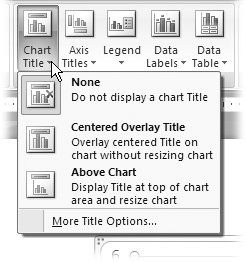 | Figure 6-11. Choosing to display a title creates a text box on your chart, laid out according to your specifications. As with virtually every gallery in PowerPoint 2007, selecting More Options kicks up a dialog box that lets you fine-tune the chart element you're working with (here, your chart's title). | | -
Choose any Chart Title option but None. PowerPoint inserts a text box on your slide to hold the title text. -
Click in the text box and type the title you want. You can choose More Title Options from the same menu (Figure 6-11), if you wish, and display the Format Chart Title dialog box. The Format Chart Title dialog box lets you apply a 3D effect to your title, "paint" your title with a gradient or a picture, give your title a funky border, and more. 6.1.4.3. Customizing chart legends Without a legend, your chart is worthless: your audience can't tell what's being compared. To tell PowerPoint where and how to display a legend: -
On your slide, click the chart you want to modify, and then to go to Chart Tools Layout  Labels Labels  Legend. Legend. PowerPoint displays the Legend gallery you see in Figure 6-12. 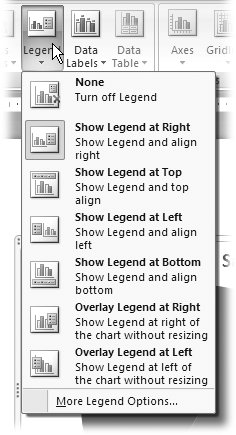 | Figure 6-12. PowerPoint pretty much offers the "None" option for consistency with other galleries only. In practice, you almost always want to show a legend. Choosing More Legend Options displays a dialog box which lets you tweak your legend's lines and background, add shadows and 3-D effects, and more. (You rarely need to lavish this much attention on an informational boxbut the options are there if you need them.) | | -
Click to choose a legend option, such as Show Legend at Right or Show Legend at Left. On your slide, PowerPoint redisplays your chart based on the legend option you selected. -
If you like, you can click the Legend icon again and choose More Legend Options. Doing so displays the Format Legend dialog box which you can use to apply 3-D, fill, and shadow effects to your legend. 6.1.4.4. Changing chart types Switching your chart's type lets you see how your data looks in a different chart configuration. With one click you can redisplay a column chart as a cone or pyramid chart. But before you follow the steps below, be sure you're changing to a chart type that works with your data. See "Choosing a Chart Type" on page 173. To change your chart's type: -
On your slide, click the chart you want to modify. PowerPoint displays the Chart Tools contextual tab. -
Go to Chart Tools Design  Type Type  Change Chart Type. Change Chart Type. The Change Chart Type dialog box appears. (Except for the title, it's identical to the Insert Chart dialog box shown back in Figure 6-5.) -
Click to select the chart type you want to change to. Hint: To make sure PowerPoint doesn't skew your data, choose a chart type in the same section as the one you're changing from. When you're finished, click OK, and PowerPoint redisplays your chart based on the new type you just selected. 6.1.4.5. Customizing data labels Data labels are small number or text labels that call attention to specific data values, series, or categories. For example, in Figure 6-13 you see four data labels: 20.4, 27.4, 90, and 20.4. Without the data labels, your audience would see the line on your line chart jog up and then down again, but they'd have to squint at the numbers on the vertical axis and guess whether their company's sales rose and then plummeted $50 million, $60 million, or $70 million. Telling PowerPoint to display data labels draws attention to these four values and lets your audience know the exact numbers in question. In addition to data labels for values, PowerPoint also lets you display data labels for series (in Figure 6-13, the three unlabeled series you see include Us, Competitor A, and Competitor B) and categories (Qtr1, Qtr2, Qtr3, and Qtr4, all unlabeled in Figure 6-13).  | Figure 6-13. Data labels help you call attention to specific values, data series, or categories you want to emphasize in your chart. In this example, data labels make the drop from 90 to 20.4 million dollars more dramatic and unmistakable than it would be without them. | |
To add data labels to your chart: -
On your slide, click the chart you want to modify. PowerPoint displays the Chart Tools contextual tabs. -
Go to Chart Tools Layout  Labels Labels  Data Labels. Data Labels. The Data Labels gallery shown in Figure 6-14 appears. 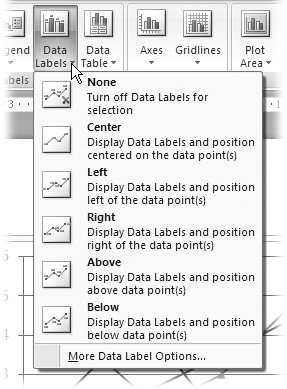 | Figure 6-14. The Data Labels gallery options you see here have to do with label placement. If you want to change the content of the label, you have to click More Data Label Options, which displays the Format Data Labels dialog box shown in Figure 6-15. | | -
Choose a label type. PowerPoint applies the selected label to your chart. -
If you wish to change the data labels that PowerPoint displays from values to data series or categories, or to tweak label placement or appearance, choose Chart Tools Layout  Labels Labels  Data Labels Data Labels  More Data Label Options. More Data Label Options. The Format Data Labels dialog box shown in Figure 6-15 appears.  | Figure 6-15. The Format Data Labels dialog box lets you change label content as well as fine-tune the position and appearance of your data labels. PowerPoint offers a dialog box similar to the one you see here for virtually every element of every object you can place on a slide. | | -
On the left side of the dialog box, click to choose the part of the data label you want to change. PowerPoint redisplays the dialog box to show options related to your selection. -
Turn on the checkboxes and radio buttons next to the options you want to select. Repeat steps 4 and 5 until you're satisfied with the way your data labels look. Then click Close. 6.1.4.6. Adding shapes (or pictures) to charts Along with data labels, adding a shape to your chart is a great way to focus your audience's attention on the point you're trying to make (see Figure 6-13 for an example). PowerPoint lets you add any kind of shape or image to your chart. Some of the most useful include arrows, callouts, and flowchart symbols. You can also add images you've created showing a product or logo, if that's appropriate for your chart. To add a shape to your chart, simply click the chart, and then go to Chart Tools Layout  Insert Insert  Shapes. In the Shapes gallery that appears, click the shape you want to add to your chart and click-drag on your slide. (Choose Insert Shapes. In the Shapes gallery that appears, click the shape you want to add to your chart and click-drag on your slide. (Choose Insert  Text Box to add text to your shape, if you like.) Text Box to add text to your shape, if you like.) It's equally easy to add an image to your chartlike a scanned-in picture file, digital photo, or drawing. Click your chart, and then go to Chart Tools Layout  Insert Insert  Picture. From there, the steps you take to add a picture to your chart are identical to the steps you take to add a picture directly to your slide. (This is covered in detail on page 300.) Picture. From there, the steps you take to add a picture to your chart are identical to the steps you take to add a picture directly to your slide. (This is covered in detail on page 300.)
Note: Adding an image to your chart is different from painting individual data marker shapes (columns, pie pieces, and so on) with a picture. If the latter effect is what you're after, select the shape you want to paint; then choose Chart Tools Format  Shape Styles Shape Styles  Shape Fill Shape Fill  Picture. Picture.
6.1.4.7. Customizing axis titles Bar charts, line charts, and several other types of charts work by showing the relationship between whatever you're showing on the vertical y-axis, and whatever you're showing on the horizontal x-axis. In Figure 6-13, the y-axis represents millions of dollars, and the x-axis represents a year broken out in quarterly increments . Without axis titles, your audience can't tell what your chart means. PowerPoint lets you automatically add qualifiers, such as "thousands" or "millions." You can even choose the position for your axis titles. To add, modify, or reposition axis titles: -
Click your chart, and then go to Chart Tools Layout  Labels Labels  Axis Titles. Axis Titles. You see two submenus: Horizontal Axis Title and Primary Vertical Axis Title. Figure 6-16 shows the options that appear when you choose Primary Vertical Axis Title. -
From the submenu, click to choose an option. PowerPoint redisplays your chart based on the option you chose. 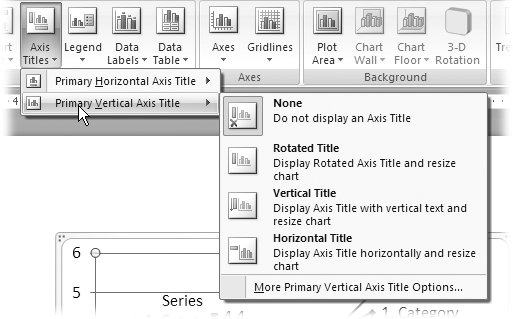 | Figure 6-16. You always want to display axis titles. Otherwise, your audience won't know what kind of information your chart's showing. The only time you should turn them off in this gallery is if you're adding them in a different way (by inserting a custom image or text box, for example). | |
6.1.4.8. Adding (and customizing) data tables When you add a data table to your chart, as shown back in Figure 6-13, you risk making your audience's eyes glaze over. After all, a data table is just rows of numbers you've pasted in from a spreadsheet. The whole point of using a chart is so your audience can get the meaning of the spreadsheet numbers at a glance. Still, if you're charting only a few data series, or if you're going to be presenting your slideshow on a huge overhead screen, or if your audience includes more than the usual number of skeptics, then adding a modestly- sized data table can help drive home your point by backing up your visual representation with hard, cold numbers. Your chart already has a data table behind the scenes. You just need to tell the program to display it. Click the chart where you want to add a data table, and then go to Chart Tools Layout  Labels Labels  Data Table. From the submenu that appears, choose Show Data Table, or (better) Show Data Table with Legend Keys. PowerPoint sticks your data table below your chart. Data Table. From the submenu that appears, choose Show Data Table, or (better) Show Data Table with Legend Keys. PowerPoint sticks your data table below your chart. You almost never want to customize precisely how the data table appears, but for that five percent of the time when you do , select More Options to specify things like colored or dashed borders around each cell. 6.1.4.9. Manually formatting chart elements You've seen how to apply a Chart Style and Chart Layout scheme to your chart, and you've tweaked individual chart elements using the options on the Chart Tools Design and Chart Tools Layout contextual tabs. But suppose you've done all that and something's not quite right. Admit ityou're a perfectionist, and you want one of your data series to appear just slightly more transparent than all the others (ten percent more transparent, to be precise). NOSTALGIA CORNER
Templates: The New User -Defined Custom Type | | Because it can take a long time to manually tweak a chart just the way you want it, PowerPoint gives you a way to save your tweaked chart so that you or your coworkers can reuse it again later, with different data. In PowerPoint 2003, you saved your custom formatting selections as a "user-defined custom type." In PowerPoint 2007, you simply save them as a reusable template. Here's how. -
Format your chart the way you want it. -
Choose Chart Tools Design  Type Type  Save As Template. Save As Template. -
Illustrations  Chart. (Or, to switch from an existing chart type, choose Chart Tools Design  Change Chart Type.) In either of the dialog boxes that appear, click the Template folder to seeand selectyour saved template, as shown in Figure 6-17. |
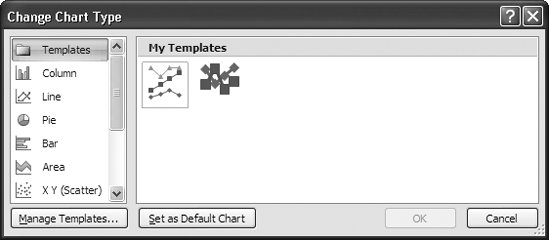 | Figure 6-17. PowerPoint 2007 lets you custom format a chart as a reusable template (see the box above for full details). After you save your chart as a template, it automatically appears in the list of selectable charts in the Insert Chart and Change Chart dialog boxes (click Templates to see it). | |
PowerPoint lets you customize your chart even further by applying all of the same formatting effects that you can apply to a text box or an image to every single element of your chart. Custom format your chart using the Chart Tools Format contextual tab, shown in Figure 6-18.  | Figure 6-18. You may never need to tweak the formatting of your chart elements manually using the tool on the Chart Tools Format tab, but it's nice to know you can. | |
To format individual chart elements manually: -
On your slide, click the chart you want to work with. Then go to Chart Tools Format. You see the tools shown in Figure 6-17. Since you're now formatting an individual chart element, rather than your chart as a whole, you have to tell PowerPoint which element to work on. -
At the far left of the Chart Tools Format tab, click the drop-down menu (Figure 6-19), and then select the chart element you want to format. On your slide, PowerPoint highlights the chart element you selected from the menu. 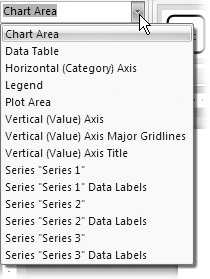 | Figure 6-19. Chart elements sometimes overlapthe title over a gridline over the plot area, for example. Sometimes it's impossible to select one just by clicking, the way you select other slide elements. So PowerPoint gives you a better way: a drop-down menu of chart elements. This menu shows the elements you've added to your particular chart. | | -
Use the options in the Chart Tools Format tab to format your selection. For help in using these formatting options, check out Chapter 3. You can also fine-tune each element by clicking Format Selection, which pops up the same dialog box (Format Chart Area, Format Date Series, and so on) you see when you customize that element by clicking an option on the Layout tab and, from the menu that appears, choosing More Options.
Note: If you customize an element and then decide you want to undo your changes, click Chart Tools Format  Current Selection Current Selection  Reset to Match Style. Reset to Match Style.
6.1.5. Pasting Existing Charts into PowerPoint If you've already created a chart in another Microsoft Office 2007 program like Excel or Word, you'll probably find it easier to paste the chart onto your PowerPoint slide than to recreate it from scratch in PowerPoint. To paste a chart from another Microsoft Office program into PowerPoint: -
In a Word document or Excel spreadsheet, for example, select the chart you want to copy. Then press Ctrl+C. Make sure you're selecting the chart as an object, not spreadsheet cells or any other text. -
In PowerPoint, click the slide on which you'll paste the chart. Then go to Home  Clipboard Clipboard  Paste Paste  Paste Special (or press Ctrl+Alt+V). Paste Special (or press Ctrl+Alt+V). PowerPoint kicks up a Paste Special dialog box similar to the one shown in Figure 6-20. Make sure the radio button next to Paste is turned on. 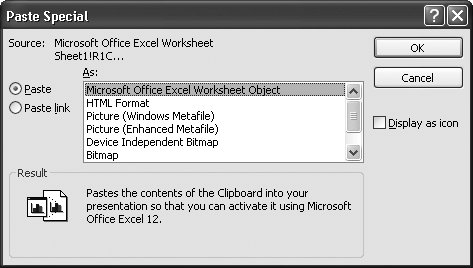 | Figure 6-20. Whether you lose or retain the ability to edit your chart after you paste it into PowerPoint depends on which option you choose in the Paste Special dialog box. If you want to work with your chart after you paste it into Excel, always select the Document Object option. (This chart was copied from an Excel document, so the option reads Microsoft Office Excel Document Object.) | | -
If you want to be able to edit the chart's underlying data or tweak each individual display element of the chart after you paste it into PowerPoint, select the Document Object option. Otherwise, if you don't mind flattening the chart into an uneditable picture, then choose one of the other options (all of which are essentially interchangeable). After you've made your choice, click OK. PowerPoint displays the newly pasted chart on your slide. If you chose the Document Object option, clicking the pasted chart displays the Chart Tools contextual tab, which you can use to tweak the chart's appearance (see page 181). If you chose a picture file format, PowerPoint treats the pasted chart as it would any other picture (see Chapter 9).
Note: If you choose to paste your chart as a picture file (such as .png, .gif, or .jpg), you can still modify your chart's overall appearance in PowerPoint after you paste it. For example, you can resize, rotate, and recolor it, just as you can any other image. You just can't edit individual chart elements. See page 307 for details.
 |
 Type
Type  Change Chart Type), but be aware that the switch may affect your data. Switching from a line chart to a pie chart can produce a slick-looking result, but it tells PowerPoint to ignore all but one category of datawhich can obviously have disastrous consequences if what you really intended to convey was the relationship between two categories.
Change Chart Type), but be aware that the switch may affect your data. Switching from a line chart to a pie chart can produce a slick-looking result, but it tells PowerPoint to ignore all but one category of datawhich can obviously have disastrous consequences if what you really intended to convey was the relationship between two categories.  Data
Data  Edit Data.
Edit Data.  Shape Styles
Shape Styles  Shape Fill
Shape Fill  Picture.
Picture.  Current Selection
Current Selection  Reset to Match Style.
Reset to Match Style. 


















